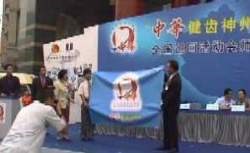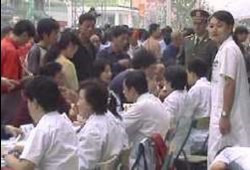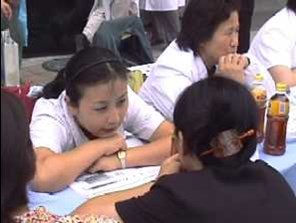China - A campaign on "Love Teeth Day" celebrated nation-wide each year
China - A campaign on "Love Teeth Day" celebrated nation-wide each year
Background and Rationale
A national oral health survey for schoolchildren in China 1982-84 demonstrated that the prevalence of caries in the 12-year-olds was low (0.7 DMFT and1.4 DMFT in Beijing) but unfilled caries in children was high (more than 95% for China and 88.2% in Beijing). Data from urban areas indicated that dmft increased during the period 1980 - 1986, from 4.15 to 5.5 in pre-school children aged 1 - 6 years in Beijing and dmft for the same age group increased from 2.6 to 4.7 during 1981 to 1990 in Shanghai. It was pointed out that caries was rapidly increasing in developing urban areas of China and as a developing nation China appeared destined to repeat the experience of an epidemic increase in caries incidence unless effective preventive measures were undertaken.
Outline of the Programme
A massive campaign on "Love Teeth Day" (LTD) was initiated and celebrated nation-wide each year in China since 1989 in order to implement preventive oral health care and oral health education. Nine government and non-governmental organizations (Ministry of Health, Central Patriotic Public Health Campaign Committee, Minsitry of Education, Ministry of Culture, Ministry of Radio, film and television, All-China Federation of Trade Union, Central Committee of Chinese Communist Youth League, All-China Women's Federation, China National Committee on Ageing) jointly supported that the 20th of September of each year be designated as the Love Teeth Festival in China. The main activities were planned and conducted by the National Committee for Oral Health, which was formed in 1988. However committees were also set up at province, county and municipal levels to support preventive oral care (in the Chinese rural infrastructure, the health care delivery system of a county consists of 3 levels - village, township and county). Various forms of mass media were used for the dissemination of oral health messages to the public - radio, television and newspapers.

The LTD campaign initiated activities to take place over the following 12 months. The aims of LTD were to motivate the people's awareness of dental self-care, participation and to promote community involvement in oral health education programmes. The theme and slogan of the campaign were different each year so as to provide information in a fresh and interesting way to the people (table).
| Year | Theme | Central Slogan |
| 1989 | Tooth brushing & oral health | Everybody brush her/his teeth twice a day (morning, night) with correct methods, qualified tooth brushes & fluoridated toothpaste |
| 1990 | Health through oral health | Love teeth, care for teeth & be healthy & strong |
| 1991 | Children & oral health | Taking good care of children's teeth, starting from the earliest stages of life |
| 1992 | Love teeth, care for teeth & be healthy & strong | Taking good care of your teeth, starting from very early in one's life & practising first on your self |
| 1993 | Love teeth, Strengthen teeth & improve health | Brush teeth every day, check up teeth regularly |
| 1994 | Oral health | Oral health for a healthy life |
| 1995 | Fluorides and oral health | Appropriate use of fluorides, prevent carries effectively |
| 1996 | Diet habits and oral health | Less sugar and better oral health |
| 1997 | Oral health and prevention of caries and periodontal diseases | Healthy teeth for your life time |
| 1998 | Oral health and social civilization | Healthy teeth, bright smile |
| 1999 | Oral health for the elderly | Oral health for all |
| 2000 | Avoid Dental Injuries | Oral health is care |
| 2001 | Smoking and oral diseases | Smoking harms oral health |
Themes and central slogans for each campaign
Four county-based community models:
- Yuncheng in Shanxi Province (1984)
- Linkou in Helongjian Province (1986)
- Wuyi in Zejiang Province (1988)
- Zelimomen in Inner Mongolia (1988)
were set up by the health authorities.


Is the programme a success?
The results of the LTD campaign show a remarkable improvement in the oral health status especially in the rural children living in the model areas. In 1989 only 4.5 million people were covered by the LTD activities and by 1992 nearly 600 million people or 54% of the population of China were included. The percentage of people with caries fell from 49.8% (1986) to 38.7% (1990), the DMFT dropped from 1.0 to 0.7 and the fillings rate increased from 0.1% to 11.7% at 12 years of age. Initially 14,000 dental professionals and health workers participated in 1989, which increased to 40,000 in 1992. As a result oral health knowledge - assessed at 37% in 1989 - rose to 76.2% in 1992.
The findings from a 4 year study of LTD indicates that the activities that started in 1989 in 3 municipalities, 26 capitals of provinces and some large cities had by 1992 spread to most cities in the urban sector and to 300 counties in the rural sector (in the Chinese rural infrastructure, the health care delivery system of a county consists of 3 levels - village, township and county). Clearly this is a successful public health programme. These community models are still developing and hopefully in the future increase the proportion of the population covered by oral health care services.
References
Bian J.Y. Love your Teeth Day, World Health, 1994; 47: 13-14.
Bian J.Y. et al. "Evaluating the Social Impact and Effectiveness of Four-year "Love Teeth Day" Campaign in China, Adv Dent Res 1995; 9: 130-133.
Peng B. et al. Changes in oral health knowledge and behaviour 1987-95 among inhabitants of Wuhan City, PR China, Int Dent J 1997; 47: 142-147.
More pictures...
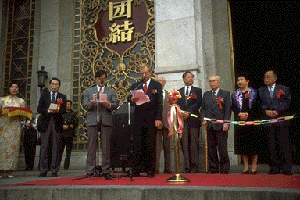
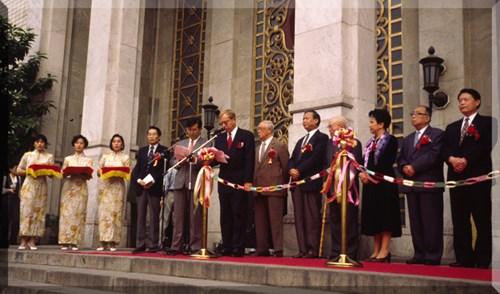

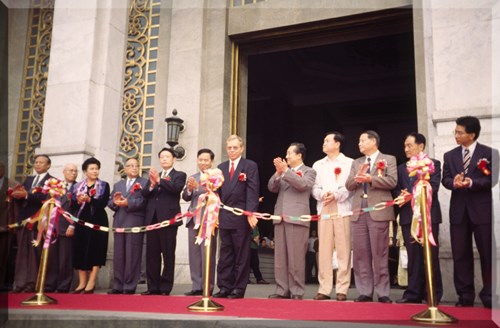

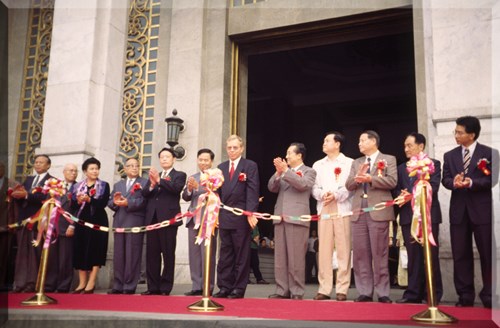
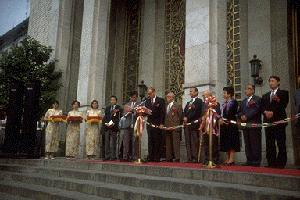
Opening ceremony

Dr. Lewis Purdell and interpretor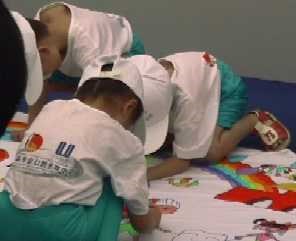
Drawing dragon teeth




